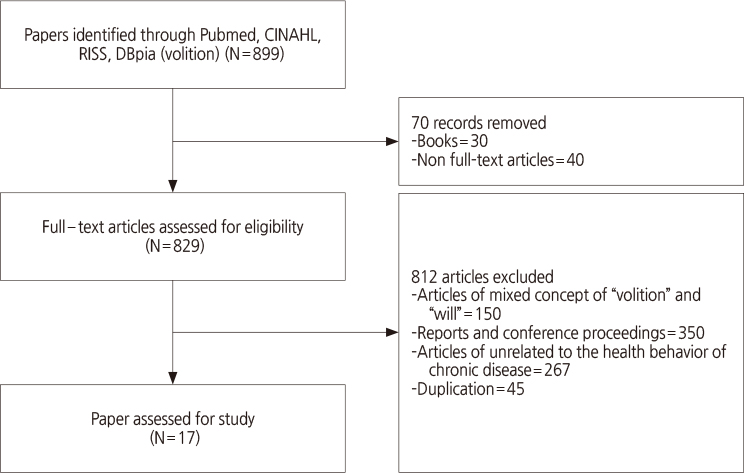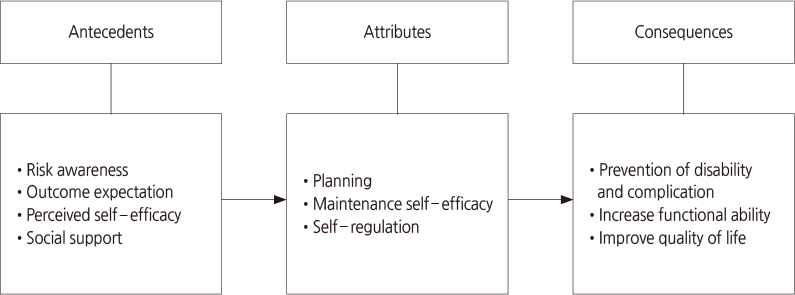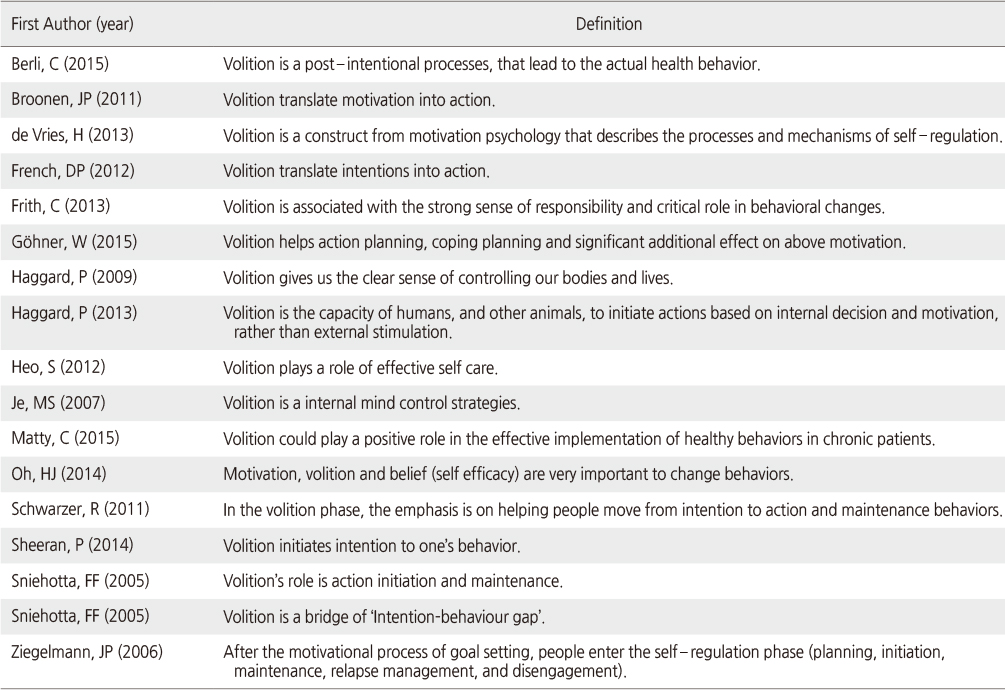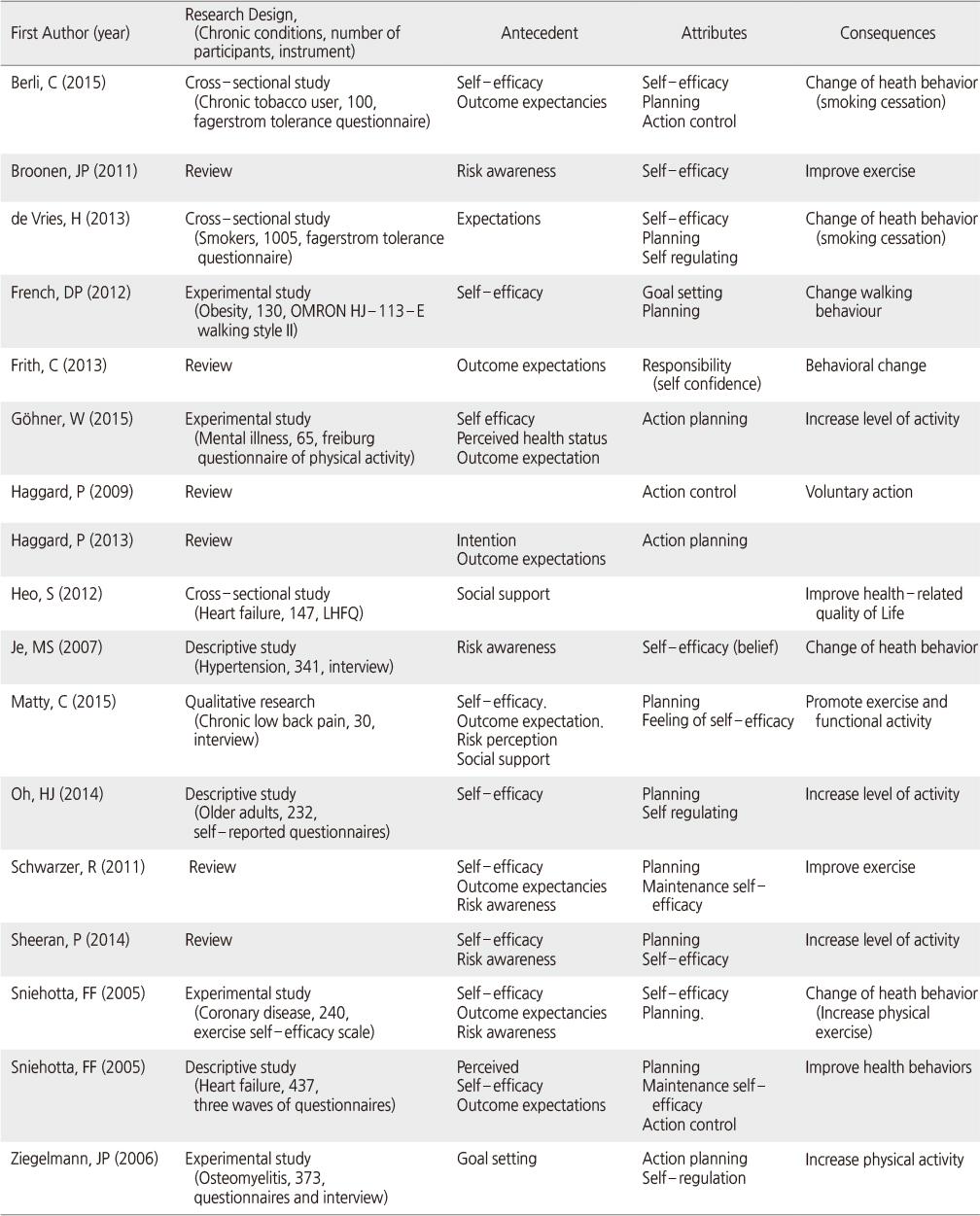Articles
- Page Path
- HOME > J Korean Acad Nurs > Volume 46(5); 2016 > Article
-
Original Article
- Concept Analysis of Volition for Health Behavior Practice in Patients with Chronic Disease
- Mi Ja Lee, Min Ju Kim
-
Journal of Korean Academy of Nursing 2016;46(5):687-696.
DOI: https://doi.org/10.4040/jkan.2016.46.5.687
Published online: October 31, 2016
Division of Nursing Science, College of Health Science, Ewha Womans University, Seoul, Korea.
- Address reprint requests to: Lee, Mi Ja. Division of Nursing Science, College of Health Science Ewha Womans University, 52, Ewhayeodae-gil, Seodaemun-gu, Seoul, Korea. Tel: +82-2-2227-0078, Fax: +82-2-312-1568, lmj2564@hanmail.net
© 2016 Korean Society of Nursing Science
This is an Open Access article distributed under the terms of the Creative Commons Attribution NoDerivs License. (http://creativecommons.org/licenses/by-nd/4.0/) If the original work is properly cited and retained without any modification or reproduction, it can be used and re-distributed in any format and medium.
Abstract
-
Purpose
- The purpose of this study was to define and clarify the concept of volition for health behavior.
-
Methods
- For this study the process of Walker & Avant’s concept analysis was used. Seventeen studies from electronic data basses met criteria for selection.
-
Results
- Volition can be defined by the following attributes: 1) planning, 2) maintenance of self-efficacy, and 3) self regulation. The antecedents of volition consisted of: 1) risk awareness, 2) outcome expectation, 3) perceived self-efficacy, and 4) social support. The consequences occurring as a result of volition were: 1) prevention of disability and complications, 2) improvement of functional ability, and 3) enhencement of quailty of life.
-
Conclusion
- Definition and attributes of volition identified by this results can be applied to develop measurements and intervention programs for chronic patients health behavior.
This study was supported by the SAMSUNG card scholarship.
The authors declared no conflict of interest.
- 1. Atkinson JW, Birch D. An introduction to motivation. 2nd ed. New York, NY: Van Nostrand; 1978. p. 1–405.
- 2. Weiner B. A theory of motivation for some classroom experiences. J Educ Psychol. 1979;71(1):3–25.ArticlePubMed
- 3. Kehr HM. Implicit/explicit motive discrepancies and volitional depletion among managers. Pers Soc Psychol Bull. 2004;30(3):315–327. ArticlePubMedPDF
- 4. Heckhausen H, Kuhl J. From wishes to action: The dead ends and shortcuts on the long way to action. In: Frese M, Sarini J, editors. Goal-directed behavior: Psychological theory and research on action. Hillsdale NJ: Lawrence Erlbaum Associates; 1985. p. 134–160.
- 5. Pintrich PR, Schunk DH. Motivation in education: Theory research and practice. Upper Saddle River, NJ: Prentice Hall; 1996. p. 1–434.
- 6. National Institute of Korean Language. Standard Korean dictionary. Seoul: Doosan Dong A; 1999.
- 7. Haggard P, Lau H. What is volition? Exp Brain Res. 2013;229(3):285–287. ArticlePubMedPDF
- 8. Kuhl J. Self-regulation and metamotivation: Computational mechanisms, development and assessment. In: Kanfer R, Ackerman PL, Cudeck R, editors. The Minnesota symposium on learning and individual differences. Abilities, motivation, and methodology. Hillsdale, NJ: Erlbaum; 1989. p. 343–374.
- 9. Walker LO, Avant KC. Strategies for theory construction in nursing. 5th ed. Upper Saddle River, NJ: Prentice Hall; 2011. p. 1–243.
- 10. YBM Si-sa. Si-sa elite English-Korean dictionary. 6th ed. Seoul: YBM; 2006.
- 11. Gollwitzer PM. Volition. In: Kazdin AE, editor. Encyclopedia of psychology. Washington, DC: American Psychological Association; 2000. p. 210–214.
- 12. Kuhl J. Volitional aspects of achievement motivation and learned helplessness: Toward a comprehensive theory of action control. Prog Exp Pers Res. 1984;13:99–171.PubMed
- 13. Dörnyei Z. Motivation in action: Towards a process-oriented conceptualisation of student motivation. Br J Educ Psychol. 2000;70(Pt 4):519–538.ArticlePubMed
- 14. Beckmann J. Metaprocesses and the regulation of behavior. In: Halisch F, Kuhl J, editors. Motivation, intention, and volition. Berlin, DE: Springer; 1987. p. 371–386.
- 15. Kuhl J. Motivation, konflikt und handlungskontrolle [Motivation, conflict, and action control]. Berlin, DE: Springer; 1983. p. 1–356.
- 16. In: Heckhausen J, Heckhausen H. editors. Motivation and action. New York, NY: Cambridge University Press; 2008. p. 1–508.
- 17. Park DY. An analysis on the causal structure of academic cognition·affection·conation and achievement [dissertation]. Cheongju, Korea National University of Education. 2000;1–206.
- 18. Elbe AM, Szymanski B, Beckmann J. The development of volition in young elite athletes. Psychol Sport Exerc. 2005;6(5):559569Article
- 19. Corno L. Self regulating learning: A volitional analysis. In: Zimmerman DJ, Schunk DH, editors. Self regulated learning and academic achievement: Theory, research and practice. New York, NY: Springer; 1989. p. 111–141.
- 20. Ko YK, Kim HK, Choi BS. Analyses of volition strategy by achievement level of the students with high learning motivation. J Korean Assoc Sci Edu. 2006;26(3):376–384.
- 21. Berli C, Ochsner S, Stadler G, Knoll N, Hornung R, Scholz U. Volitional processes and daily smoking: Examining inter- and intraindividual associations around a quit attempt. J Behav Med. 2015;38(2):306–317. ArticlePubMedPDF
- 22. Scholz U, Nagy G, Schüz B, Ziegelmann JP. The role of motivational and volitional factors for self-regulated running training: Associations on the between- and within- person level. Br J Soc Psychol. 2008;47(Pt 3):421–439.ArticlePubMed
- 23. Norman P, Abraham C, Conner M. Understanding and changing health behaviour: From health beliefs to self-regulation. 2nd ed. Amsterdam, NL: Harwood Academic Publishers; 2010.
- 24. Bandura A. Self-efficacy: The exercise of control. New York, NY: W. H. Freeman & Company; 1997. p. 1–604.
- 25. Heo S, Moser DK, Chung ML, Lennie TA. Social status, health-related quality of life, and event-free survival in patients with heart failure. Eur J Cardiovasc Nurs. 2012;11(2):141–149. ArticlePubMedPMCPDF
- 26. Sniehotta FF, Scholz U, Schwarzer R. Bridging the intention-behaviour gap: Planning, self-efficacy, and action control in the adoption and maintenance of physical exercise. Psychol Health. 2005;20(2):143–160. Article
- 27. French DP, Stevenson A, Michie S. An intervention to increase walking requires both motivational and volitional components: A replication and extension. Psychol Health Med. 2012;17(2):127–135. ArticlePubMed
- 28. Luszczynska A, Schwarzer R. Planning and self-efficacy in the adoption and maintenance of breast self-examination: A longitudinal study on self-regulatory cognitions. Psychol Health. 2003;18(1):93–108. Article
- 29. Sheeran P, Harris PR, Epton T. Does heightening risk appraisals change people's intentions and behavior? A meta-analysis of experimental studies. Psychol Bull. 2014;140(2):511–543. ArticlePubMed
- 30. Ziegelmann JP, Lippke S, Schwarzer R. Adoption and maintenance of physical activity: Planning interventions in young, middle-aged, and older adults. Psychol Health. 2006;21(2):145–163. ArticlePubMed
REFERENCES
Figure & Data
REFERENCES
Citations

- Concept analysis of transition to motherhood: a methodological study
Woon Young Hwang, Sun Yeob Choi, Hae Jeong An
Korean Journal of Women Health Nursing.2022; 28(1): 8. CrossRef - Conceptual Analysis of Health Behavior in Tuberculosis Patients
Hye-Jin Kim, Myung Kyung Lee
Korean Journal of Adult Nursing.2022; 34(3): 280. CrossRef - Factors Affecting the Intention to Modify Lifestyle in the Cardiovascular Disease Risk Group in Korea
JaeLan Shim, KyungAe Kim
Healthcare.2021; 9(5): 496. CrossRef


Figure 1
Figure 2
Definitions of Volition for Health Behavior Practice in Patients with Chronic Disease in Literature Review
Antecedent, Attributes and Consequences of Volition in Literature Review
OMRON HJ-113-E Walking Style II: Omron’s GOsmart™ Dual-Axis Pocket Pedometers; LHFQ: Living with Heart Failure Questionnaire.
OMRON HJ-113-E Walking Style II: Omron’s GOsmart™ Dual-Axis Pocket Pedometers; LHFQ: Living with Heart Failure Questionnaire.
 KSNS
KSNS
 E-SUBMISSION
E-SUBMISSION




 Cite
Cite

